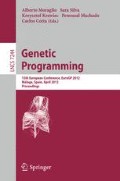Abstract
We present the effect of bloat on the efficiency of incremental evolution of locomotion of simulated snake-like robot (Snakebot) situated in a challenging environment. In the proposed incremental genetic programming (IGP), the task of coevolving the locomotion gaits and sensing of the bot in a challenging environment is decomposed into two subtasks, implemented as two consecutive evolutionary stages. In the first stage we use genetic programming (GP) to evolve a pool of morphologically simple, sensorless Snakebots that move fast in a smooth, open terrain. Then, during the second stage, we use this pool to seed the initial population of Snakebots that are further subjected to coevolution of their locomotion control and sensing morphology in a challenging environment. The empirical results suggest that the bloat no immediate effect on the efficiency of the first stage of IGP. However, the bloated seed contributes to a much faster second stage of evolution. In average, the second stage with bloated seed reaches the best fitness values of the parsimony seeds about five times faster. We assume that this speedup is attributed to the neutral code that is used by IGP as an evolutionary playground to experiment with developing novel sensory abilities, without damaging the already evolved, fast locomotion of the bot.
Access this chapter
Tax calculation will be finalised at checkout
Purchases are for personal use only
Preview
Unable to display preview. Download preview PDF.
References
Huynen, M., Stadler, P., Fontana, W.: Smoothness within ruggedness: the role of neutrality in adaptation. Proceedings of the National Academy of Sciences of the United States of America 93, 397–401 (1996)
Wilke, C., Wang, J., Ofria, C., Lenski, R., Adami, C.: Evolution of digital organisms at high mutation rates leads to survival of the flattest. Nature 412, 331–333 (2001)
Wagner, A.: Robustness, evolvability, and neutrality. FEBS Letters 579(8), 1772–1778 (2005)
Galván-López, E., Poli, R., Kattan, A., O’Neill, M., Brabazon, A.: Neutrality in evolutionary algorithms... what do we know? Evolving Systems 2, 145–163 (2011)
Ebner, M.: On the search space of genetic programming and its relation to nature’s search space. In: Proceedings of the 1999 Congress on Evolutionary Computation, CEC 1999, pp. 1357–1361 (1999)
Vassilev, V.K., Miller, J.F.: The Advantages of Landscape Neutrality in Digital Circuit Evolution. In: Miller, J.F., Thompson, A., Thompson, P., Fogarty, T.C. (eds.) ICES 2000. LNCS, vol. 1801, pp. 252–263. Springer, Heidelberg (2000)
Yu, T., Miller, J.F.: The role of neutral and adaptive mutation in an evolutionary search on the onemax problem. In: GECCO Late Breaking Papers 2002, pp. 512–519 (2002)
Collins, M.: Finding needles in haystacks is harder with neutrality. In: GECCO 2005: Proceedings of the 2005 Conference on Genetic and Evolutionary Computation, vol. 2, pp. 1613–1618 (2005)
Beaudoin, W., Verel, S., Collard, P., Escazu, C.: Deceptiveness and neutrality: The nd family of fitness landscapes. In: GECCO 2006: Proceedings of the 2006 Conference on Genetic and Evolutionary Computation, pp. 507–514 (2006)
Doerr, B., Gnewuch, M., Hebbinghaus, N., Neumann, F.: A rigorous view on neutrality. In: IEEE Congress on Evolutionary Computation, CEC 2007, pp. 2591–2597 (September 2007)
Lobo, J., Miller, J.H., Fontana, W.: Neutrality in technological landscapes. In: Santa Fe Working Paper (2004)
Brameier, M., Banzhaf, W.: Neutral Variations Cause Bloat in Linear GP. In: Ryan, C., Soule, T., Keijzer, M., Tsang, E.P.K., Poli, R., Costa, E. (eds.) EuroGP 2003. LNCS, vol. 2610, pp. 286–296. Springer, Heidelberg (2003)
Gelly, S., Teytaud, O., Bredeche, N., Schoenauer, M.: Universal Consistency and Bloat in GP. Revue d’Intelligence Artificielle 20, 805–827 (2006)
Poli, R., McPhee, N.F.: Covariant parsimony pressure for genetic programming. Technical Report CES-480, Department of Computing and Electronic Systems, University of Essex, UK (2008)
Kuyucu, T., Tanev, I., Shimohara, K.: Incremental genetic programming via genetic transpositions for efficient coevolution of locomotion and sensing of simulated snake-like robot. In: European Conference on Artificial Life, pp. 439–446 (2011)
Shipman, R.: Genetic redundancy: Desirable or problematic for evolutionary adaptation. In: 4th International Conference on Artificial Neural Networks and Genetic Algorithms (ICANNGA 1999), pp. 1–11 (1999)
Tanev, I., Ray, T., Buller, A.: Automated evolutionary design, robustness and adaptation of sidewinding locomotion of simulated snake-like robot. IEEE Transactions on Robotics 21, 632–645 (2005)
Morowitz, H.J.: The Emergence of Everything: How the World Became Complex. Oxford University Press (2002)
Koza, J., Keane, M., Yu, J., Bennett, F., Mydlowec, W.: Automatic creation of human-competitive programs and controllers by means of genetic programming. Genetic Programming and Evolvable Machines 1, 121–164 (2000)
Tanev, I., Shimohara, K.: Co-evolution of active sensing and locomotion gaits of simulated snake-like robot. In: Proceedings of the 10th Annual Conference on Genetic and Evolutionary Computation, GECCO 2008, pp. 257–264. ACM, New York (2008)
Smith, R.: Open Dynamics Engine (2004)
Tanev, I.T.: Dom/xml-based portable genetic representation of the morphology, behavior and communication abilities of evolvable agents. Artificial Life and Robotics 8, 52–56 (2004)
Author information
Authors and Affiliations
Editor information
Editors and Affiliations
Rights and permissions
Copyright information
© 2012 Springer-Verlag Berlin Heidelberg
About this paper
Cite this paper
Tanev, I., Kuyucu, T., Shimohara, K. (2012). The Effect of Bloat on the Efficiency of Incremental Evolution of Simulated Snake-Like Robot. In: Moraglio, A., Silva, S., Krawiec, K., Machado, P., Cotta, C. (eds) Genetic Programming. EuroGP 2012. Lecture Notes in Computer Science, vol 7244. Springer, Berlin, Heidelberg. https://doi.org/10.1007/978-3-642-29139-5_21
Download citation
DOI: https://doi.org/10.1007/978-3-642-29139-5_21
Publisher Name: Springer, Berlin, Heidelberg
Print ISBN: 978-3-642-29138-8
Online ISBN: 978-3-642-29139-5
eBook Packages: Computer ScienceComputer Science (R0)

